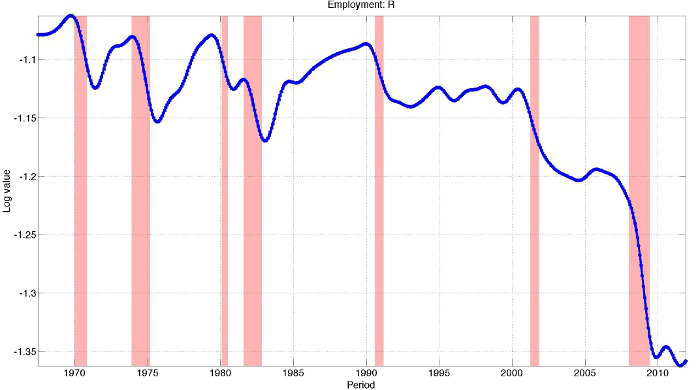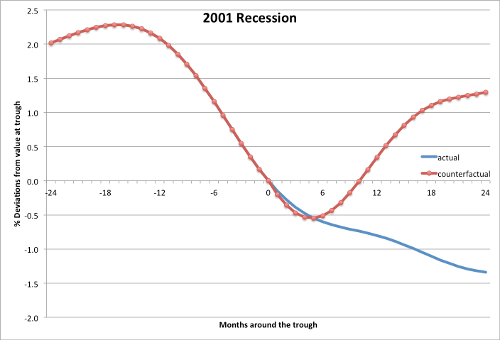Economic recoveries aren’t what they used to be. Since the end of the Great Recession in June 2009:
- US real GDP per capita grew by 3.6%,
- but per capita employment fell by 1.8% over and above the 5.5% that was lost during the recession.
This malaise in the US labour market has been the subject of countless economic policy debates and may be the decisive factor in the upcoming US election. The fact that employment is recovering much slower than GDP is a relatively new phenomenon; jobless recoveries have only really occurred after the recessions of 1991 and 2001. These last three recoveries represent a distinct break from previous postwar episodes of recession when both GDP and employment would vigorously rebound following recessions (Schreft and Singh 2003; Groshen and Potter 2003; Bernanke 2009).
Our current research indicates that a jobless recovery is not simply an ‘economy-wide‘ delay in firms hiring again. Instead, it can be traced to a lack of recovery in a subset of occupations; those that focus on “routine” or repetitive tasks that are increasingly being performed by machines (Jaimovich and Siu 2012).
Job polarisation
The fact that employment in routine occupations has been disappearing is well documented by recent job polarisation literature (Acemoglu 1999, Autor et al. 2006, Goos and Manning 2007, Goos et al. 2009, Autor and Dorn 2012). This literature finds that occupations focused on routine tasks tend to be middle-waged. Thus, the disappearance of routine occupations in the past 30 years represents a ‘polarisation’ of employment because the middle of the wage distribution has been hollowed out.
As recently as the mid-1980s, about one in three Americans over the age of 16 was employed in a routine occupation. Currently, that figure stands at one in four. The fact that polarisation is occurring should not surprise anyone who understands the influence of robotics and automation on machinists and machine operators in manufacturing. Indeed, the influence of robotics is increasingly being felt on routine occupations in transportation and warehousing. Of equal importance is the disappearance of routine employment in ‘white-collar’ occupations - think bank tellers being replaced by ATMs, or secretarial work being replaced by personal computers and Siri, Apple’s iPhone-integrated ‘intelligent personal assistant’. Thus, all of the per capita employment growth of the past 30 years has either been in ‘non-routine’ occupations located at the high-end of the wage distribution, such as software engineers and economists, or in low-paying jobs, such as service occupations like restaurant waiters and janitors. For this last set of occupations, this has been especially true in the past decade.
Jobless recoveries
What is surprising is the link between job polarisation and the business cycle. Figure 1 highlights our simple point; it plots per capita employment in routine occupations (in log levels) from 1967 to the end of 2011. Since about 1990, there is an obvious 28 log point decline in routine employment. What is equally clear is that this fall has not happened gradually over time but that the decline is concentrated in economic downturns. 92% of the 28 log point fall occurred within a 12 month window of NBER-dated recessions.
Figure 1
Following each of the 1991, 2001, and 2009 recessions, per capita employment in routine occupations fell and never recovered. This lack of recovery in routine employment accounts for the jobless recoveries experienced in the aggregate. Indeed, prior to job polarisation, routine job losses in recessions were accompanied by strong routine job recoveries. This is evidenced in Figure 1 after the recessions of 1970, 1975, and 1982. Unsurprisingly, prior to job polarisation, jobless recoveries did not occur. Moreover, jobless recoveries cannot be traced to the business cycle behaviour of ‘non-routine’ jobs: employment in these occupations experience only mild contractions, if at all, during recessions, and have experienced essentially no change in the nature of their recoveries over the past half century.
Explaining jobless recovery
A simple counterfactual experiment clarifies the link between job polarisation and jobless recoveries. Specifically, we ask what the recoveries in aggregate employment would have looked like if routine employment had rebounded as it did prior to job polarisation. Would the US economy still have experienced jobless recoveries? For the 1991, 2001, and 2009 recessions, we replace the per capita employment in routine occupations (following the trough) with the average recoveries following the 1970, 1975, and 1982 recessions. We then sum up the actual employment in non-routine occupations with the counterfactual employment in routine occupations to obtain a counterfactual aggregate employment series.
The behaviour of these counterfactual series around the recent NBER recessions is displayed in Figures 2a to 2c. The solid blue line indicates the time path of actual per capita employment. Date 0 indicates the month in which the NBER officially declared the end of the recession. As is clear, aggregate employment continued to fall for many months following the end of each recession. Note that the hatched red line represents the counterfactual series. Had employment in routine occupations recovered as it did prior to job polarisation, the US economy would not have experienced jobless recoveries. Hence, we argue that jobless recoveries can be attributed to the lack of recovery in routine jobs.
Figure 2
Concusions
Structural change in the labour market is clearly manifesting itself in the business cycle. The long-term decline in routine occupations is occurring in spurts - employment in these jobs is lost during recessions. The reach of job polarisation is wide. Automation and the adoption of computing technology is leading to the decline of middle-wage jobs of many stripes, both blue-collar jobs in production and maintenance occupations and white-collar jobs in office and administrative support. It is affecting both male- and female-dominated professions and it is happening broadly across industries –manufacturing, wholesale and retail trade, financial services, and even public administration.
The loss of routine jobs in recent recessions has given rise to jobless recoveries. Aggregate employment struggles to rebound following recessions since middle-wage, routine occupations no longer recover. Moreover, employment growth following recent recessions has been unevenly distributed across pay, concentrated in high- and low-wage occupations. A recent report by the National Employment Law Project (2012) indicates that the recovery from the Great Recession has been particularly lopsided, with the majority of jobs added being low-paying jobs.
The pace of job polarisation was greatly accelerated in this last recession, and the pace of automation and progress in robotics and computing technology is not slowing down either (Brynjolfsson and McAfee 2011). If the past 30 years is any guide, we should expect future recessions to continue to spur job polarisation. Jobless recoveries may be the new norm.
References
Acemoglu, D (1999), “Changes in unemployment and wage inequality: An alternative theory and some evidence”, American Economic Review, 89(5), 1259–1278.
Autor, D H and D Dorn (2012), “The growth of low skill service jobs and the polarization of the U.S. labor market”, American Economic Review, forthcoming.
Autor, D H, L F Katz, and M S Kearney (2006), “The polarization of the U.S. labor market”, American Economic Review: Papers & Proceedings, 96(2), 189–194.
Bernanke, B S (2009), “On the outlook for the economy and policy”, Speech at the Economic Club of New York, 16 November.
Brynjolfsson, E and A McAfee (2011), Race Against The Machine: How the Digital Revolution is Accelerating Innovation, Driving Productivity, and Irreversibly Transforming Employment and the Economy, e-book, Digital Frontier Press.
Goos, M and A Manning (2007), “Lousy and lovely jobs: The rising polarization of work in Britain”, Review of Economics and Statistics, 89(1), 118–133.
Goos, M, A Manning, and A Salomons (2009), “Job polarization in Europe”, American Economic Review: Papers & Proceedings, 99(2), 58–63.
Groshen, E L and S Potter (2003), “Has structural change contributed to a jobless recovery?“, Current Issues in Economics and Finance, Federal Reserve Bank of New York , 9(8), 1–7.
Jaimovich, N and H E Siu (2012), “The trend is the cycle: job polarization and jobless recoveries”. NBER Working Paper, 18334.
National Employment Law Project (2012), “The low-wage recovery and growing inequality”, Data Brief, August.
Schreft, S L and A Singh (2003), “A closer look at jobless recoveries”, Economic Review, Federal Reserve Bank of Kansas City, Second Quarter, 45–72.






